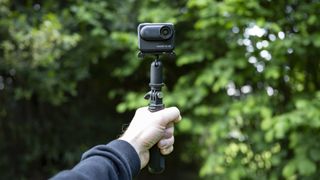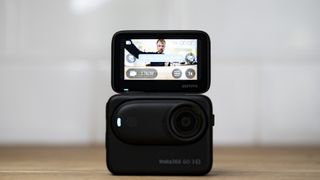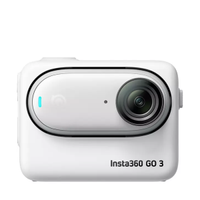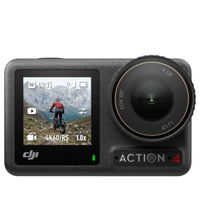The Insta360 Go 3S is one of the most fun cameras I’ve ever used, encouraging a degree of creative thinking that you don’t get with your phone or bulkier cameras. Its tiny build, versatile magnetic mounting and useful accessories allow you to position the camera for unique POVs, including hands-free first-person perspectives. In situations where you can’t or don’t want to use your phone – be it underwater, as a pet-view cam, or in the middle of the sporting action – the Go 3S steps in, ably supported by the Action Pod for better battery life and remote viewing. The camera’s increased 4K resolution makes the handy multi-aspect FreeFrame mode all the better for TikTok and YouTube reels, and makes the Go 3S a worthy update of the Go 3.
Pros
- +
Tiny build and easy magnetic mounting get unique hands-free POVs
- +
Action Pod expands functionality and is a useful app-free viewfinder
- +
Handy shoot-first-frame-later video, now in 4K
Cons
- –
Action Pod isn’t fully waterproof
- –
Overall image quality not as good as bulkier action cams
- –
Action Pod’s Bluetooth range is limited
- –
Modest battery life
Why you can trust TechRadar We spend hours testing every product or service we review, so you can be sure you’re buying the best. Find out more about how we test.
Insta360 Go 3S: two-minute review
The new Go 3S is the latest in a line of the world’s smallest action cameras by Insta360, with convenient magnetic mounting and useful accessories for hands-free operation and unique POVs. When your phone won’t do or can’t be risked, the tiny and fully waterproof Go 3S steps up.
It updates the one-year-old Insta360 Go 3 with some key upgrades, chiefly bumping video resolution up from 2.7K to 4K. This makes its handy multi-aspect video recording even more appealing for TikTok and YouTube reels. It’s also equipped with Apple Find My, which is a useful addition to a tiny 1.38oz / 39.1g camera.
Higher resolution video is the main improvement here. Otherwise, there’s nothing majorly new in the Go 3S and much of the information in our Go 3 review is relevant to the latest iteration. However, the Go 3S is still a worthy upgrade and one of the most creative and best action cameras available.
Insta360 Go 3 specs:
Weight: GO 3S camera: 1.38oz / 39.1g; Action Pod: 3.4oz / 96.3g
Dimensions: GO 3S camera: 1.0 x 2.1 x 1.0in / 25.6 x 54.4 x 24.8mm ; Action Pod: 2.5 x 1.9 x 1.2in / 63.5 x 47.6 x 29.5mm
Maximum video resolution: 4K: 3830 x 2160 pixels at 24/25/30fps
Maximum photo resolution: 12MP (4:3); 9MP (16:9)
Connectivity: USB-C 2.0, Bluetooth 5.0, Wi-Fi 5GHz
Storage: 32GB, 64GB, 128GB
Battery capacity: GO 3S: 310mAh; Action Pod: 1,270mAh
Quoted run time: Go 3S: 38 mins; Action Pod: 140 mins (for 1080p 30fps video
Its waterproofing depth, double the Go 3 at up to 33ft / 10m, increases slow motion frame rates with up to 200fps in 1080p and it comes equipped with a slightly wider lens.
There’s also a neat trick – the Go 3S will automatically switch video aspect ratio based on whether it’s horizontal or vertical when filming starts. Sporty types might be interested in the Garmin / Apple / Coros stats overlay option for Go 3S videos.
Gesture control has been added to voice command control, so you can position the Go 3S and start recording without needing to be hands-on, or have the Action Pod element to hand – the pod that’s pictured below transforms the Go 3S into a Go-Pro-like action cam.
While the Action Pod transforms the Go 3S’ handling and makes it a suitable vlogging camera, it isn’t fully waterproof like the camera is, or a dedicated action camera like the DJI Osmo Action 4, so you can’t use the pairing everywhere.

Naturally, there are some compromises versus bulkier alternatives. Battery life from the tiny 310mAh battery is limited to 38 minutes when shooting Full HD video. That’s less than its predecessor’s 45 minutes and way less than other action cameras, such as the GoPro Hero 12 Black and Insta360’s own X4 360-degree camera.
Overall image quality doesn’t compare, either. Although Insta360 says the Go 3S is ‘Dolby Vision-Ready’ with new HDR technology, there’s no HDR video mode like you’d get in a camera such as the DJI Osmo Action 4, meaning you lose out on highlight and shadow detail when lighting is less than perfect. Photos are capped at 12MP in 4:3 or 9MP in 16:9, too.
However, you’re buying into the Insta360 Go series for its unrivaled versatility. It’s why we rated the Go 3 as the perfect camera for FPV drones and a superb hands-free camera ideal for BTS video and first-person perspectives.
My kids have been super busy getting creative with the Go 3S, attaching it to the soccer goal in the garden, our family dog’s collar on walks, and inside the guineapig hutch to see what our cute furballs get up to away from prying eyes (not much, it turns out).
A quick online search further reveals clever ways people have used a Go camera, shooting from angles you couldn’t otherwise consider, such as inside a box for unboxing videos.
And when paired with the Action Pod its functionality is improved, as is battery life, boosted to 140 minutes of 1080p video recording. Being able to choose between the standalone camera and pairing it with the Action Pod further increases versatility.
It might not be perfect, but the Go 3S is edging ever closer and is an excellent smartphone alternative for creative filmmakers.

Insta360 Go 3S: price and availability
- Launched on June 13, 2024
- Bundles from $399.99 / £349.99 / AU$719.99
- Can be bought as a standalone without the Action Pod, from $239.99 / £209.99 / AU$429.99
The Insta360 Go 3S can be bought standalone or bundled with the Action Pod. Those that already have the Go 3 but want to upgrade to the Go 3S for its 4K video and new features can save a bit by opting for the standalone option. Like a phone, you can buy the Go 3S in different storage capacities, in this case, 64GB or 128GB versions – the Go 3S has internal memory only.
The Standard Edition Go 3S bundled with the Action Pod costs $399.99 / £349.99 / AU$719.99 for the 64GB version, or $429.99 / £369.99 / AU$769.99 for the 128GB version. The standalone 64GB Go 3S is priced at $239.99 / £209.99 / AU$429.99 and it’s $269.99 / £229.99 / AU$479.99 for the 128GB one. Overall, the Go 3S hovers around the Go 3 launch price, give or take $20 / £20 / AU$40 – in the UK it’s cheaper than before.
I had the Standard Edition bundle in ‘Midnight Black’. In the box comes a magnet pendant (lanyard), pivot stand (tripod mount), easy clip (for hats and animal collars, etc), and an adhesive plate. That’s a generous selection of accessories (see gallery, below), but additional accessories, such as the 2-in-1 selfie stick that you can see in some of the pictures, are also available on the Insta360 website.
- Price score: 4.5/5
Insta360 Go 3S: design
- The Insta360 Go 3S weighs just 1.34oz / 39.1g or 4.78oz / 135.4g with the Action Pod
- Convenient magnetic mounting and handy supplied accessories
- Increased waterproofing up to 33ft / 10m
The Insta360 Go 3S comprises two elements; the camera and the Action Pod – the latter transforms the Go 3S into a GoPro-style action camera. Without the Action Pod, you have one of the smallest and lightest action cameras available. It has has no real rival.
Both elements are made from rigid plastic. I’d be happy to put them in harm’s way – they’ve taken the occasional knocks from fast-moving balls and clumsy drops, and come out unscathed.
The thumb-sized Go 3S is a twinge heavier and a fraction deeper than the Go 3 but, otherwise, maintains the same dimensions, meaning it’ll work with the same accessories. Put the two cameras side by side and you’d be hard-pressed to note any difference: we’re talking a few mere millimeters and grams.

It pairs with the exact same Action Pod to boost battery life and for easy navigation of settings, plus remote control and viewing. Those who already own the Go 3 but want the Go 3S can save a little by opting for the standalone camera over the bundle.
The camera element has just one button that starts and stops recording. It’s equipped with a built-in microphone, internal memory (64GB or 128GB), and a magnetic mount along its back. This forms a strong connection with metal surfaces and Insta360 Go accessories, including into the cavity of the Action Pod.
The Action Pod is pretty simple, too. Its control layout includes a USB-C port for charging, lock button to release the docked camera, on/off button, quick menu for shooting modes, and a flip-up touchscreen that reminds me a lot of the Insta360 X4’s: it’s responsive and large enough to view clearly, and therefore very useable for remote functions instead of the Insta360 Studio app.
It also features a magnetic underside for snapping into place on accessories such as the Pivot Stand, although at almost 3.5oz / 100g the pod is too heavy for placing sideways onto metal surfaces.

I love the versatility you get with the Go 3S. As a standalone camera, it’s the smallest and lightest in the business and super convenient for hands-free videos. Inserted into the Pod, you get easy viewing for vlogs, selfies, and so on. There’s a third option, too: remotely controlling and viewing what the camera sees through the Action Pod even when it’s disconnected.
There are times you’ll want just the Go 3S camera, such as in tight spaces and underwater: it’s waterproof up to 33ft / 10m, but the Action Pod is only splash-proof. It may look like an action camera in the Action Pod, but only the camera element can be classed as an action camera.
- Design score 4.5/5
Insta360 Go 3S: features and performance
- Reliable Bluetooth connection between Go 3S and Action Pod, albeit with limited range
- Modest battery life
- Effective gesture control and voice command
Both the Go 3S and Action Pod are slick, quick to start up and pair effortlessly. The two elements enjoy a seamless Bluetooth connection when divided, and the Action Pod’s real-time view and remote controls are super responsive.
There is a natural limit to the range the Bluetooth connection covers, so the Action Pod won’t work for remote view and control in several scenarios. You’ll lose connection beyond the range of a few meters, and sooner still with the Go 3S underwater.
You can also remotely control the Go 3S using the Insta360 app, although the dedicated user interface of the Action Pod will have you leaning to that instead of your phone.

Battery life is a sour note: 38 minutes is respectable for such a tiny camera, but one of the inevitable compromises versus a dedicated action camera. And battery life is less than the Go 3 camera in like-for-like tests recording 1080p video.
To counter this limit, the Go 3S can extend record times by going to sleep for video modes, such as TimeShift and Timelapse. And virtually all the shooting modes are super simple to use and create decent footage with.
You can also boost battery life by docking the camera into the Action Pod, which has a maximum 140-minute life.
Gesture control and voice commands are pretty reliable and it’s handy having both options: when you’re in noisy environments gesture control is useful. You also get confirmation that filming has started by way of the flashing red light on the front of the Go 3S.
Image stabilization is reasonable, but there are smoother systems out there and the best shots you get with the Go 3S are when it’s mounted to a stationary object rather than strapped to a rapidly moving one. You’ll get the best results by utilizing the gyroscope.
- Features & performance score: 4/5
Insta360 Go 3S: image and video quality
- Improved video quality, but still not quite as good as rival dedicated action cams
- Wider and versatile lens
- HDR is for photos only
Insta360 has addressed the limited video and photo quality of the Go 3 by increasing resolution. We now get 4K video and 12MP stills, versus 2.7K video and 6.6MP stills. If this increased resolution is all that Insta360 upgraded from the Go 3, it would be enough to greatly bolster the Go 3S’ appeal, but there’s more.
Videos are sharper than before, with Insta360 also pinpointing 50% increased CPU power and better dynamic range thanks to Dolby Vision-Ready HDR technology. You can see the difference from the Go 3 but I think that overall quality still lags behind the best action cams like the Osmo Action 4 and Hero 12 Black, especially when lighting is anything other than optimum.
Still, it’s a price worth paying to obtain what are otherwise impossible shots.

Increased resolution is super handy for filmmakers regularly switching between vertical, square, and horizontal formats to shoot Instagram, TikTok and YouTube-ready content. The FreeFrame mode is particularly helpful for this, as you can shoot first and pick the aspect later. Multi-aspect shooting is also better supported by a slightly wider angle lens.
You also get tracking autofocus, with visual confirmation when faces have been detected on the Action Pod’s screen proving useful when vlogging. The ultra-wide angle and small image sensor naturally provide great depth of field. There’s no official minimum focus distance listed in the product spec sheet, but objects very close to the camera won’t be in focus.
For photos, you do get an HDR option which generally gets you the best results. Overall, colors are pleasant and auto exposure works pretty well, plus you can override it with exposure compensation to brighten or darken the image where needed.
Videos are recorded onto internal memory. I had the 128GB version and shot a lot of footage before the card filled up. Thankfully, even the 4K video files only take up a sensible amount of memory.
- Image and video quality score: 4/5
Insta360 Go 3S: testing scorecard
Swipe to scroll horizontally
| Price | No real increase in price from the Go 3, and comes with useful accessories | 4.5/5 |
| Design | Modular build with the Action Pod factored in. The tiny magnetic camera fits places other cameras cannot | 4.5/5 |
| Features & Performance | Increased video resolution, decent array of video and photo modes and some neat tricks such as Garmin stats overlay | 4/5 |
| Image and video quality | Versatility over outright performance: video quality and battery life can’t quite compare with dedicated action cameras | 4/5 |
Should I buy the Insta360 Go 3S?
Buy it if…
You want the smallest action camera available
The Insta360 Go 3S is part of the Go series that boasts the smallest and lightest video cameras in the business and gets you otherwise impossible shots.
You want a fun camera for all the family
I’ve reviewed hundreds of cameras and am a father of three, and the Go 3S has kept its appeal for all of us longer than any other camera I can think of.

